Abstract
In order to study the harmful effects of seismic waves generated by the bursting of large-diameter high-pressure gas pipelines, through two half-buried three-pipe air bursting tests and with the use of three-vector velocity sensors, vibration speeds in three different directions when pipe bursting seismic waves propagate along the surface can be obtained. Propagation characteristics and spectral characteristics of pipe bursting seismic waves can be gained by comparison and the Fourier transform analysis of the autocorrelation function. According to results, major seismic wave energy concentrates in 0-100 Hz frequency range where the maximum power spectral density corresponds to a frequency, which is less than 10 Hz and has strong destructive impacts on the buildings around the pipelines. Linking test results to safety threshold that have been studied allows some data to be acquired. When natural gas pipelines are under construction, the safe distance between parallel buried pipelines is 60-70 m; from pipelines to traffic tunnels and mine workings the safe distance is 50-100 m; from pipelines to the buildings it is100-240 m.
1. Introduction
With the rapid development of China oil and natural gas industry, the construction of oil and gas pipeline develops at a staggering rate. However, under the limited condition of terrain, traffic, cost and so on, a plurality of parallel pipes or laying in one ditch is inescapable [1-3]. Therefore, once the high-pressure gas pipelines burst during the operation, it will not only cause ground casualties, destruction of buildings and facilities, but also the failure of other running pipelines nearby, thereby expanding the scope of damage as well as causing more severe economic loss [4, 5].
Among the hazard effects of gas pipelines burst and leak, air shock wave and surface seismic waves did not taken seriously enough. However, once pipelines burst [3, 6], the tube wall open quickly (less than 5 ms) and the compressed gas expands rapidly, releasing large amounts of energy, which causing huge impact on surrounding rock and soil medium. As propagation distance increases, the impact energy will be transmitted in the form of seismic waves. When transmitted to buried pipelines, it leads to the vibration of pipe structure and even the failure of the pipeline due to its excessive deformation if a certain intensity of vibration is reached. Therefore, studying intensity and propagation characteristics of seismic waves in rock and soil medium produced by the bursting of large diameter high pressure gas pipeline plays a key role in determining a safe distance between parallel pipelines and pipes laid in the same ditch and relative protective measures[1]. At the same time, as to buildings (or structures) around the natural gas pipelines, it is of crucial importance to determine the anti-seismic measures for them and a safe distance from these buildings [5].
In this paper, through two half-buried three-pipe air burst test, the seismic wave characteristics and propagation rules generated by large-diameter high pressure gas pipeline blasting can be obtained. Combined with vibration security criteria, the safe distance between buried pipelines and buildings can be calculated by quantitative analysis.
2. Description of the experiments
2.1. Experimental set-up
Test pipeline are 3 low-alloy high-strength X90 pipes connecting by welding. Each pipe is 11 m in length, with external diameter of 1219 mm and wall thickness of 16.3 mm. After being welded together, three pipelines were sealed at both ends with the help of plugs and placed in the groove of 1 m depth, as is shown in Fig. 1. And then, connecting the cap-ended pipeline to three compressors with gas piping which made of flexible material with multiple layers. Then, install a 500 mm long linear explosive cutter on the upper geometric center of the pipeline to trigger initial crack (Fig. 1). In order to measure the gas pressure and temperature in test pipeline, a pressure transducer and temperature transducer was mounted on the pipeline respectively.
Fig. 1Testing facility
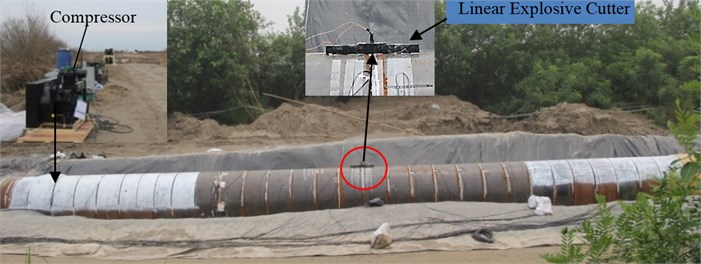
According to Fig. 2, the seismic wave measuring points (MP) were laid in the direction with an angle of 45° between the pipe axial and the direction vertical pipe axial. Laid on the ground surface, overall, there were eight measuring points set up in the first test and the distances between each measuring point and initiation point are shown in Fig. 2(a). Second test set up 10 and the farthest measurement point (10#) was about 99 m away from the initiation point.
Fig. 2Measuring point layout (unit: m)
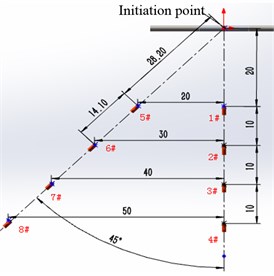
a) 1st test
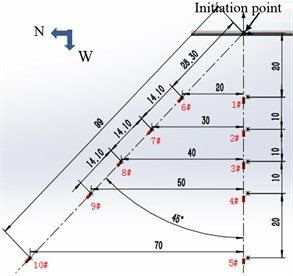
b) 2st test
2.2. Instrumentation and test procedure
These tests used TC-4850 vibration measurement instrument produced by the Chengdu Zhongke and consisting of three vector velocity sensor and TC-4850 blasting data acquisition device. During the tests, the three vector velocity sensor were buried and fixed in the earth and the X-axis is directed at initiation point.
The test procedure involves five main steps as following described: 1) Pressurizing the cap-ended pipeline up to 12 MPa (corresponding to the delivery pressure of gas pipeline) with compressor, 2) Wait for the internal temperature drop to the level of surroundings, 3) Charge with the charge compressor up to the burst pressure again (the internal pressure would decrease due to the temperature drop, 4) Set vibration measurement instruments in trigger status, 5) Detonating the explosive cutter.
3. Results and discussion
3.1. Test results and analysis
Two tests were conducted in February and July 2015 respectively at Dongtai, Jiangsu Province. After the explosive cutter was detonated, the high pressure gas ejected from the opening and expanded rapidly. Fig. 3 shows a view of bursting process and results. According the data recorded by pressure transducer, the gas in the pipeline flows out completely within 0.1 s and expands in the air rapidly, compresses the surrounding at a high speed, which caused the ground under severe impact thus form seismic wave in the ground.
Fig. 3Bursting process and results
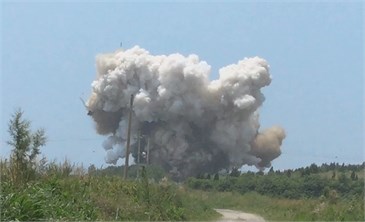
a) Bursting process
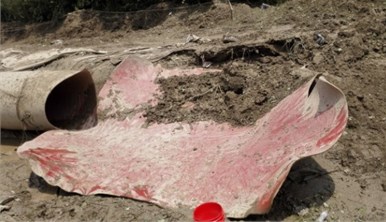
b) Part of pipeline after bursting
Fig. 4Vibration velocity of 2# MP in 2st test
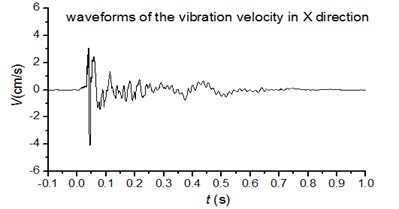
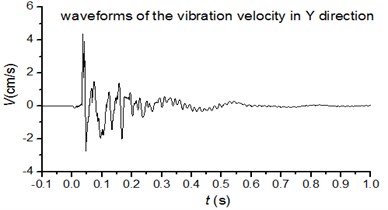
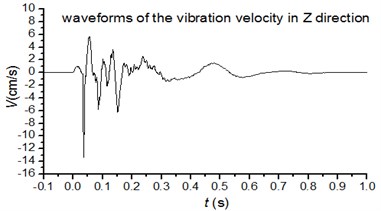
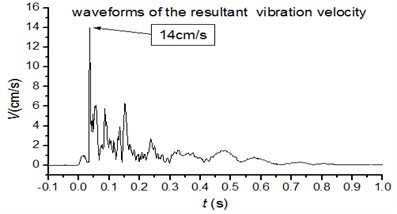
Wave propagation in rock and soil medium is a synthesis of complex fluctuations. Since the propagation velocity of longitudinal wave, shear wave and surface wave vary from each other, the number of peak values during the process of vibration at the measuring point can be seen from test results (Fig. 4). Fig. 4 is the vibration velocity curve of direction X, Y, Z and its vector sum in 2# measuring point (2st test), showing the vibration duration is approximately 0.55 s and vibration velocity peak value in Z-axis direction (i.e. the direction perpendicular to the ground) is higher than that in direction X (i.e. the direction linking measuring point with explosion source) and Y (vertical to the X-axis direction and Y-axis direction).
According to test results, the peak values of vibration velocity at every point in three directions are then aggregated and plotted as a graph. In Fig. 5 and Fig. 6, the fitting curve presents the relationship between distance and vibration velocity peak value of seismic waves formed by two pipe bursting tests. Through analyzing test results, the following conclusions can be obtained: 1) As the distance from the explosion source increases, the vibration peak value in ground surface falls. If close to explosion source (within 30 m), the vibration peak value declines quickly. If it is over 30 m away from the explosion source, the vibration peak value shows basically a linear attenuation; 2) In the same position, the vibration peak value in Z-axis direction is higher than that in X-axis and Y-axis direction. Within 50 m away from explosion source, vibration peak value in X-axis direction is higher than that in Y-axis direction, however, as the propagation distance rise, these two peak values tend to be same.
Fig. 5Blasting vibration velocity peak value vs distance (1st test)
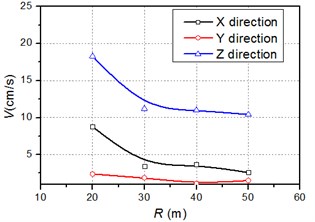
a) Vertical pipe axial
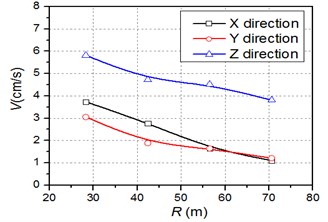
b) Pipe axial 45°
Fig. 6Blasting vibration velocity peak value vs distance (2st test)
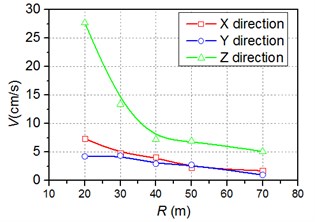
a) Vertical pipe axial
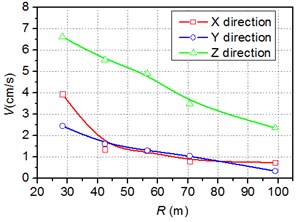
b) Pipe axial 45°
According to the long-term researches at home and abroad, the destructive effects of bursting vibration on the buildings (or structures) not only associate with the peak velocity bursting vibration but also closely relate to the corresponding dominant frequency [7]. Thus, when determining safety criterion of bursting vibration, vibration peak frequency and peak value of vibration velocity have all been taken into account. To study the destructive characteristics of seismic waves formed during the bursting of large-diameter natural gas pipelines, vibration velocity data at measuring point 2# in Z-axis direction is Fourier transform of autocorrelation function, thus, power spectral density-frequency curve can be acquired, as is shown in Fig. 5. The figure illustrates that major energy of seismic waves when large diameter high-pressure gas pipeline burst concentrates mainly in 0-100 Hz frequency range in which 8 Hz corresponds to the maximum power spectral density. According to the relevant literature, the natural vibration frequencies of buildings (or structures) is generally 2-20 Hz. Hence, bursting seismic waves are easier to form resonance with the surrounding buildings (or structures) and cause greater damage to it.
According to the results of two tests, the maximum vibration velocity peak value of each MP were aggregated and fitted to the graph shown in Fig. 8. As the figure shows, when the distance from ground to the explosion source is the same, the vibration peaks of the ground in the direction vertical the pipe axial is larger than that in the direction parallel pipe axial 45°, but as far from the explosion source, the two converge.
Fig. 7Power spectral density (2# MP in 2st test)
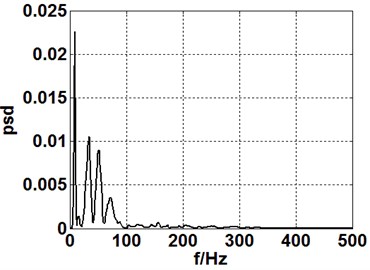
Fig. 8Vibration velocity peak value vs distance
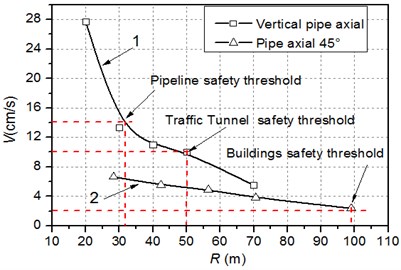
3.2. Determine the safety distance
In this paper, the latest national standard “Safety regulations for blasting (GB6722-2011)” issued by the National Bureau of Standards in 2011 was used as a safety criterion of buildings(structures) [7]. However, the above “standard” is not involved in the vibration safety standards of a similar steel structures, steel pipe components, thin-walled steel shell, steel pressure vessels, etc. In order to determine if it is safe of pipeline structure under the action of blasting seismic waves, China National Petroleum and Gas Corporation (CNPC) obtain the safety strain of pipeline which is under the explosion impact load by method of explosion tests, and the value of which is ε=2000 με. And then find out the V value which is the maximum allowable vibration velocity Vmax responding to the safety strain by explosion test. Finalize the buried pipelines maximum allowable vibration velocity Vmax= 14 cm/s, the research results have been applied in the western pipeline projects successfully [3]. In this paper, the results of the above studies as a vibration Safety Criteria for buried pipelines.
Table 1Blasting vibration safety standards [7]
Protected object categories | Allowed safety vibration velocity / (cm/s) | ||
<10 Hz | 10 Hz-50 Hz | 50 Hz-100 Hz | |
General brick houses, large blocks of non-seismic buildings | 2.0-2.5 | 2.3-2.8 | 2.7-3.0 |
Reinforced concrete structure houses | 3.0-4.0 | 3.5-4.5 | 4.2-5.0 |
Traffic tunnels | 10-20 | ||
Mine workings | 15-30 | ||
Large diameter buried natural gas pipeline | 13-14 | ||
In order to achieve a safe distance between a gas pipeline and surrounding buildings (structures) and another pipeline, the data in Fig. 8 is associated to the safety threshold in Table 1. According to the test results, when a large diameter high pressure (≥12 MPa) natural gas pipeline is bursting, the safe distance between parallel buried pipelines is 30-35 m; from bursting pipeline to traffic tunnels and mine workings the safe distance is 25-50 m; from bursting pipeline to the buildings it is100-120 m. Taking into account that the actual situation presence of a number of unfavorable factors (e.g. the problem of elevation difference; different propagation medium; the oil and gas pipelines use period are decades or even centuries, influence in the course of their service due to environmental loads, fatigue effects, corrosion effect and material aging and other unfavorable factors, will weaken the seismic capacity of the system) and other unforeseeable influence factors, the amplification factor k=2 is recommend practical application. Namely the safe distance between parallel buried pipelines is 60-70 m; from pipelines to traffic tunnels and mine workings the safe distance is 50-100 m; from pipelines to the buildings it is 200-240 m.
4. Conclusion
In this paper, through two half-buried three-pipe air burst tests, the vibration velocity in the ground surface were obtained while large diameter high-pressure gas pipelines bursting. Interrelated analyses conclude that the seismic waves caused by the bursting of high-pressure gas pipelines have the following characteristics: 1) As the distance from the explosion source increases, the vibration peak value in ground surface falls. If close to explosion source (within 30 m), the vibration peak declines quickly. If it is over 30 m away from the explosion source, the vibration peak value shows basically a linear attenuation; 2) In the same position, the vibration peak value in Z-axis direction is larger than that in X-axis and Y-axis direction; 3) At the same distance from the explosion source, vibration peak value in ground surface in the direction of vertical pipe axial is higher than that in pipe axial 45° direction, but as the distance increases, the two values have a tendency to be the same; 4) Major seismic wave energy concentrates in 0-100 Hz frequency range where the maximum power spectral density corresponds to a frequency, which is less than 10 Hz and has strong destructive impacts on the buildings around the pipelines.
Linking test results to safety threshold that have been studied allows some data to be acquired. When natural gas pipelines are under construction, the safe distance between parallel buried pipelines is 60-70 m; from pipelines to traffic tunnels and mine workings the safe distance is 50-100 m; from pipelines to the buildings it is 200-240 m. The study results not only provide an important reference for the construction of actual pipes and formulating policies about reducing vibration but also may have its theoretical and engineering application value of preventing harmful effects of seismic waves when natural gas pipelines burst.
References
-
Xu Yanxin, Ma Xuehai, Pang Baohua, et al. Determination of safety distance for parallelly laid natural gas/oil pipelines. Oil and Gas Storage and Transportation, Vol. 30, Issue 11, 2011, p. 816-818.
-
Zhao Yanhui, Wu Ming, Zhang Chunjing Research status in parallel laying technology of oil and gas pipelines. Energy Conservation Technology, Vol. 30, Issue 9, 2012, p. 447-449.
-
The Key Technology Research about the Laying of Parallel Pipelines in the Second West-East Pipeline Project. The Project Design Consortium of the Second West-East Gas Transportation Pipeline, China National Petroleum Corporation Internal Data, 2009.
-
Zhang X. M. Parametric studies of coupled vibration of cylindrical pipes conveying fluid with wave propagation approach. Computer and Structure, Vol. 80, 2002, p. 287-295.
-
Yan Zhixin, Wang Houyu Bursting Seismic Effects and Safety. Science Press, Beijing, 2011.
-
Kasmani R. M., Andrews G. E., Phylaktou H. N. Experimental study on vented gas explosion in a cylindrical vessel with a vent duct. Process Safety and Environmental Protection, Vol. 20, Issue 9, 2013, p. 245-252.
-
Safety Regulations for Bursting (GB6722-2011). National Bureau of Standards of People’s Republic of China, Standards Press of China Beijing, 2011.
-
Li Peirong Analysis of the Self-vibration of Pipe Conveying Fluid. Taiyuan University of Technology, Shanxi, 2004.
About this article
This research was supported by the National Nature Science Foundation of China, No. 51339006 and 51304218.
